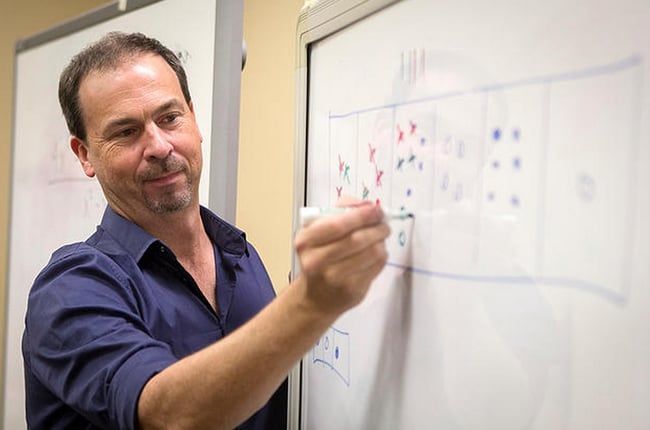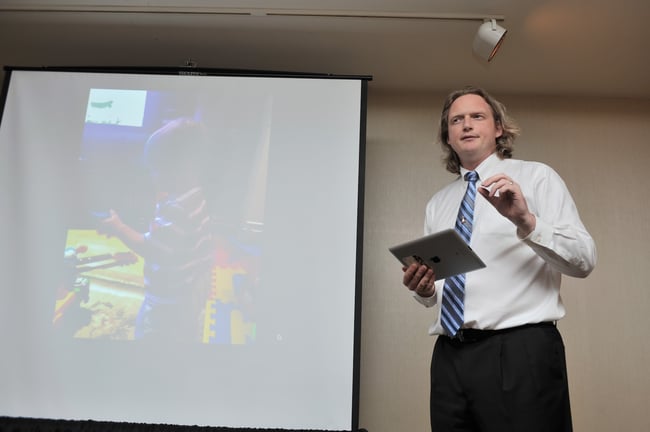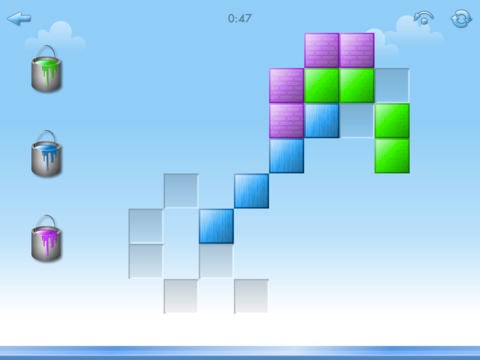
Recently, James Tanton, founder of the Global Math Project, and Nigel Nisbet, Vice President of Content Creation at MIND Research Institute, met to converse about their current projects and the state of math education. These educators-turned-social-impact-leaders share challenges and insights from decades of experience in and out of the math classroom. Here are some excerpts from their conversation.
“Mathematics is often primarily seen as a tool, a practical tool for solving practical problems, devoid of a human context and a human story,” James Tanton begins, starting to dig into the challenges of teaching mathematics.
“It’s often seen as austere and sterile at its heart,” Tanton continues. “Yet it is mathematical play and wonder and delight that lies at the heart of mathematics, that sustains mathematicians who devote their careers to mathematics, and has sustained mankind for thousands of years in doing mathematics. It is the joy of creativity and play."
With a decade of experience as a college professor, another decade of experience as a high school math teacher, and now serving as the Mathematician-at-Large for the Mathematical Association of America in Washington D.C., James Tanton has struggled alongside many other teachers to answer the question: How do we give students access to a deeper understanding of mathematics?
“Math is generally seen as devoid of creativity. People who can identify procedures and solve math problems quickly are seen as good at math. But that’s not the only way to do math, or think of it,” responds Nigel Nisbet.
“What if instead, we saw the people who are thinking creatively when problem-solving as good at math?” Nigel continues.
From teaching a class of 15 at an idyllic private all-girls school in rural England, to designing and delivering professional development programs as the Mathematics Specialist for the Los Angeles Unified School District (LAUSD), Nigel Nisbet has also lived the challenges of teaching math.
Both Tanton and Nisbet are vibrant and passionate, using their hands to shape the space and give visualizations to the meanings of their words. Their approach makes sense; they both see math in a different way. And they want to change how others see math, too.
Tanton is the founder of the Global Math Project, whose aim is to share a unifying, joyful experience of mathematics through annual online global events. The first Global Math Week will take place October 10th to 17th, 2017, with students and teachers at participating schools all over the world engaging in the same math lesson, entitled “Exploding Dots.”

James Tanton faciliating an Exploding Dots lesson.
When asked what compels him to continue this mission, Tanton responds, “I saw the state of math education as a global issue. Kids everywhere are exactly the same.”
Tanton’s statement immediately resonates with Nisbet. “When you think about very young students, and we can see this universally all over the world, they are so intrigued by the world and excited to learn. They are deeply engaged,” Nigel observes.
Somewhere along their journey through formal education though, that excitement and passion to learn dwindles, particularly in math.
“I did not enjoy math at all growing up,” Tanton admits. “And when I started in the classroom in the 90s, I noticed we were using the same curriculum as when I was a student.”
Tanton continued, noting how much science has uncovered about how the brain reasons creatively and builds knowledge, but that education hadn’t changed as much in relation.
“I had a good experience learning math as a kid,” Nigel offers. “I remember being 15 or 16 and finally really ‘seeing’ how some of these math concepts were interlinked and exclaiming, ‘Ah- ha!’ I was already able to think about math very visually and being a musician helped with that. But after that spark, mathematics became a problem-solving, creative endeavour and when I succeeded, it was invigorating.”
But when Nisbet started teaching, he saw that students lacked the mindset he had. They hadn’t felt that same sort of success with math.
“I thought, how can I personally help these students find an ‘in’ to the mathematics?” continues Nisbet. “That’s when I developed the geometry of chocolate problem. When you see 42 students in a room, taking a remedial math class, who are all super engaged and focused on a problem, that is something special.”
Nisbet challenged himself to take what he was learning about teaching and make an even greater impact on education.
Both Nisbet and Tanton went on to shift their focus from engaging in classroom instruction to leading other educators.
Nigel Nisbet is Vice President of Content Creation at the nonprofit MIND Research Institute, working to ensure all students are mathematically equipped to solve the world’s biggest problems. Colleagues at MIND created ST Math, an educational software tool that uses visualization to help students grow a conceptual understanding of mathematics.

Nigel Nisbet, Vice President of Content Creation at MIND Research Institute
“Visualization is such a powerful mathematical tool,” explains Nisbet. “When you have a strong visualization, it leads to students making connections with other areas, opening up the beauty of mathematics. And that’s really how you build your schema of knowledge. So that’s how MIND builds our games.”
“Pictures are a wonderful avenue to mathematics,” agrees Tanton. “My own goal is to declutter the curriculum. If we build a compelling storyline of the subject, you can go deeper into it, and before you know it you’re exploring polynomials naturally, for example.”
“Math is a portal to wonder and delight.”
- James Tanton, Global Math Project
“My advice for teachers is to help your students see themselves as capable of learning...that has huge ramifications. Talk about growth mindset and the [brain’s natural abilities] to open up those possibilities,” Nisbet says.
Tanton advises teachers to “be your honest true self in front of students. Wonder about math; be honest if you don’t know the answer and then help students try to find it. Model what it means to do and learn mathematics.”
Nisbet warns that “we have a tendency to classify students into levels, but that’s not always an accurate gauge of the level of thinking they’re capable of.”
“I’ve seen students who were performing poorly in math class show amazing insight and problem-solving. When you get past language, past the symbols and the procedures, all students are capable of incredible thinking,” continues Nisbet.
“When you use lots of visuals in math, there’s no language barrier. It’s universal."
-Nigel Nisbet, MIND Research Institute
“Math is a universal human experience,” concludes Tanton. “We’re all studying the same thing; it transcends language. As a common experience, math unites us.”


Calli Wright was the Marketing Manager at MIND Research Institute. She loves playing and designing board games, which she often talks about on twitter @CalliWrights.
Comment